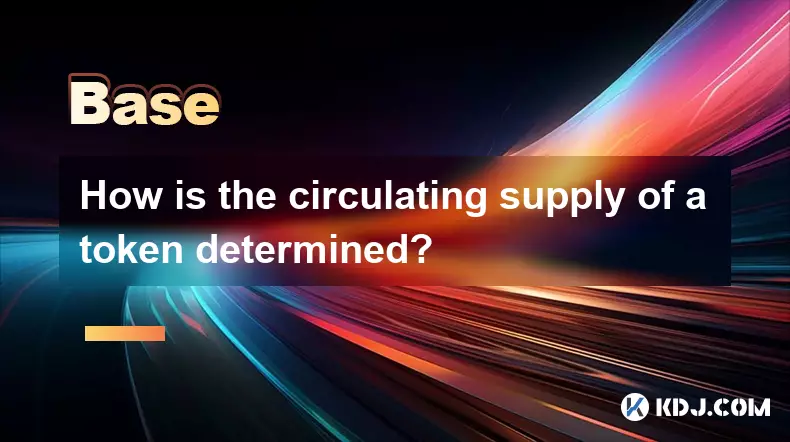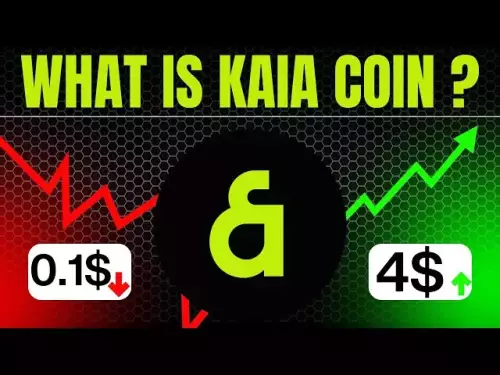-
 bitcoin
bitcoin $112715.707551 USD
-1.71% -
 ethereum
ethereum $4101.475385 USD
-3.01% -
 tether
tether $1.000644 USD
-0.02% -
 bnb
bnb $1207.619465 USD
-6.77% -
 xrp
xrp $2.501451 USD
-3.98% -
 solana
solana $202.947124 USD
-3.32% -
 usd-coin
usd-coin $1.000295 USD
0.04% -
 dogecoin
dogecoin $0.203884 USD
-4.47% -
 tron
tron $0.317154 USD
-1.72% -
 cardano
cardano $0.695009 USD
-4.43% -
 hyperliquid
hyperliquid $38.853961 USD
-8.23% -
 chainlink
chainlink $18.988674 USD
-4.64% -
 ethena-usde
ethena-usde $1.000233 USD
-0.03% -
 stellar
stellar $0.337050 USD
-3.63% -
 bitcoin-cash
bitcoin-cash $536.861728 USD
-1.28%
How is the circulating supply of a token determined?
Circulating supply reflects the number of tokens actively traded, excluding locked or reserved amounts, and is key to understanding a crypto asset's true market availability.
Oct 12, 2025 at 04:18 am

Determining Circulating Supply in Cryptocurrencies
1. The circulating supply of a token refers to the number of coins or tokens that are currently available and actively traded in the market. This figure excludes any tokens that are locked, reserved, or held in escrow by development teams, foundations, or other entities. It is considered one of the most accurate representations of a cryptocurrency’s availability for public trading.
2. Unlike total supply, which includes all issued tokens including those not yet released, circulating supply focuses only on what is practically accessible. For example, some projects distribute tokens over several years through staking rewards or team vesting schedules. These unreleased tokens are not counted until they enter public circulation.
3. Market data platforms like CoinMarketCap and CoinGecko calculate circulating supply by aggregating information from blockchain explorers, project whitepapers, and official announcements. They apply filters to exclude known reserve wallets, such as foundation holdings or ecosystem development funds.
4. Projects may issue periodic updates about token unlocks or burns, directly affecting circulating supply. A sudden increase due to a large unlock event can influence price dynamics, especially if demand does not match the new volume entering the market.
5. Inflationary models also impact circulating supply over time. Tokens with ongoing block rewards, such as certain proof-of-stake networks, see their circulating supply grow steadily as new coins are minted and distributed to validators or miners.
Factors That Influence Circulating Supply
1. Token lockups play a significant role. Many blockchain projects allocate portions of their initial supply to team members, advisors, investors, and ecosystem development. These allocations often come with multi-year vesting schedules, meaning they gradually enter circulation rather than being immediately tradable.
2. Centralized exchanges sometimes hold large quantities of user assets off-chain. While these tokens are technically under user control, they are still counted in circulating supply because they remain liquid and transferable upon request.
3. Burn mechanisms reduce circulating supply permanently. Some protocols automatically destroy a portion of transaction fees or conduct periodic buybacks and burns to create scarcity. Ethereum’s EIP-1559 introduced a base fee burn, making ETH slightly deflationary during periods of high network usage.
4. Forks and airdrops can abruptly alter circulating supply. When a new chain emerges from a fork, holders of the original asset typically receive an equivalent amount on the new network. This effectively doubles the circulating units until market forces determine value distribution between the two chains.
5. Regulatory actions or exchange delistings do not change the technical circulating supply but may restrict access, reducing effective liquidity. However, the underlying blockchain records still reflect those tokens as active unless explicitly burned or proven unspendable.
Transparency and Verification Challenges
1. Not all projects disclose wallet addresses associated with reserves or team holdings. This lack of transparency makes it difficult for third-party trackers to accurately assess true circulating supply, potentially leading to inflated market cap estimates.
2. Some tokens use complex smart contract logic to manage vesting schedules. Auditing these contracts requires technical expertise, and discrepancies can arise if the code allows early withdrawals under specific conditions not publicly disclosed.
3. Dead wallets—addresses with no private key access—still contribute to circulating supply unless verified as irrecoverable. Without formal blacklisting mechanisms, these dormant tokens remain part of the count even though they exert no market pressure.
4. Reentrancy attacks or protocol exploits might result in unauthorized minting events. If undetected, these counterfeit tokens could be included in supply metrics until a correction is made through community consensus or hard forks.
5. Community-driven audits and open-source analytics tools help improve accuracy. Platforms like Glassnode and Nansen provide insights into whale movements, exchange flows, and dormant address activity, offering deeper context beyond surface-level supply numbers.
Frequently Asked Questions
What is the difference between circulating supply and maximum supply?Circulating supply represents tokens currently available for trading, while maximum supply is the upper limit of tokens that will ever exist, if defined. Bitcoin’s maximum supply is capped at 21 million, whereas some tokens have no predefined max, allowing continuous issuance.
Can circulating supply decrease over time?Yes, through token burning. Protocols like Binance Coin (BNB) regularly destroy portions of their supply based on revenue or usage metrics. When tokens are sent to non-recoverable addresses, they are effectively removed from circulation.
Why do some tokens show a circulating supply higher than total supply on certain platforms?This anomaly usually results from delayed data synchronization or misclassification of locked tokens. It may occur after a major unlock event when tracking systems haven't updated wallet statuses, temporarily inflating the reported figure.
How do exchanges affect circulating supply calculations?Exchanges holding large reserves contribute to circulating supply since those tokens can be withdrawn at any time. However, if an exchange becomes insolvent and users lose access, those tokens remain on-chain and are still counted unless formally burned or frozen via governance action.
Disclaimer:info@kdj.com
The information provided is not trading advice. kdj.com does not assume any responsibility for any investments made based on the information provided in this article. Cryptocurrencies are highly volatile and it is highly recommended that you invest with caution after thorough research!
If you believe that the content used on this website infringes your copyright, please contact us immediately (info@kdj.com) and we will delete it promptly.
- XRP, Dogecoin, and Ozak AI: A New York Minute on Crypto's Hottest Plays
- 2025-10-15 16:25:14
- CRDB Tokenisation Service: Revolutionizing Finance in Tanzania and Beyond
- 2025-10-15 16:25:14
- Alvara Protocol Mainnet Launch: ERC-7621 Token Revolutionizes DeFi
- 2025-10-15 16:30:01
- Bitcoin, Gold, and Silver: Safe Haven Showdown in 2025
- 2025-10-15 16:30:01
- Sei Price Wobbles: Token Unlock Jitters Meet Downside Risk – A Trader's Guide
- 2025-10-15 16:45:12
- Peter Brandt, Bitcoin, and Investor Predictions: Navigating the Crypto Seas
- 2025-10-15 16:30:01
Related knowledge

How do decentralized identity (DID) solutions work?
Oct 14,2025 at 11:36pm
Understanding Decentralized Identity in the Blockchain Ecosystem1. Decentralized identity (DID) solutions are built on blockchain networks, allowing i...

What is the difference between Near Protocol and Ethereum?
Oct 15,2025 at 08:01am
Near Protocol and Ethereum: Core Architectural Differences1. Near Protocol operates on a sharded blockchain architecture known as Nightshade, which al...

What does it mean for code to be "open source" in crypto?
Oct 12,2025 at 01:54pm
Understanding Open Source in the Cryptocurrency Ecosystem1. In the context of cryptocurrency, open source refers to software whose code is publicly ac...

What is the purpose of a "testnet"?
Oct 12,2025 at 09:01am
Understanding the Role of Testnets in Blockchain Development1. A testnet serves as a parallel version of a blockchain network, designed specifically f...

How to avoid phishing scams in crypto?
Oct 13,2025 at 06:18pm
Understanding Common Crypto Phishing Tactics1. Cybercriminals frequently use fake websites that mirror legitimate crypto exchanges or wallet platforms...

What is the difference between single-collateral and multi-collateral Dai?
Oct 12,2025 at 05:18pm
Understanding Single-Collateral Dai1. Single-Collateral Dai (SCD) was the original version of the Dai stablecoin launched by MakerDAO in 2017. It allo...

How do decentralized identity (DID) solutions work?
Oct 14,2025 at 11:36pm
Understanding Decentralized Identity in the Blockchain Ecosystem1. Decentralized identity (DID) solutions are built on blockchain networks, allowing i...

What is the difference between Near Protocol and Ethereum?
Oct 15,2025 at 08:01am
Near Protocol and Ethereum: Core Architectural Differences1. Near Protocol operates on a sharded blockchain architecture known as Nightshade, which al...

What does it mean for code to be "open source" in crypto?
Oct 12,2025 at 01:54pm
Understanding Open Source in the Cryptocurrency Ecosystem1. In the context of cryptocurrency, open source refers to software whose code is publicly ac...

What is the purpose of a "testnet"?
Oct 12,2025 at 09:01am
Understanding the Role of Testnets in Blockchain Development1. A testnet serves as a parallel version of a blockchain network, designed specifically f...

How to avoid phishing scams in crypto?
Oct 13,2025 at 06:18pm
Understanding Common Crypto Phishing Tactics1. Cybercriminals frequently use fake websites that mirror legitimate crypto exchanges or wallet platforms...

What is the difference between single-collateral and multi-collateral Dai?
Oct 12,2025 at 05:18pm
Understanding Single-Collateral Dai1. Single-Collateral Dai (SCD) was the original version of the Dai stablecoin launched by MakerDAO in 2017. It allo...
See all articles


























![Staking ATH: How To Stake $ATH in October 2025 with 523% APY — [Step-By-Step Guide] Staking ATH: How To Stake $ATH in October 2025 with 523% APY — [Step-By-Step Guide]](/uploads/2025/10/15/cryptocurrencies-news/videos/staking-ath-stake-ath-october-apy-stepstep-guide/68eef94d80903_image_500_375.webp)















































